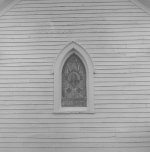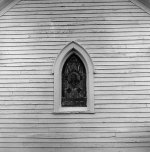Time Share
Newbie
Well I finally did it!!!!!
Shot a roll of Kodak Professional 400 TMY 120 format on my Yashica Mat 124G and developed the roll last night.
My process was as follows ...
1. Struggle in the dark with my first attempt at loading the film reel
2. Pour in TMAX Developer (1:4) and develop for 6 Minutes @ 24 C
3. 30 second stop bath consiting of 1:20 is Vinegar solution
4. Pour in Ilford Rapid Fix (1:3) for 8 Minutes
5. Rinse for 30 seconds
6. Wash by filling tank & dumping, ten times
7. Hang Film ..... very exciting to see my first negatives ... large 120 format !
8. Squeege film
9. Lightly dry with hair dryer
10. Scan some negatives on my new Epson V500 scanner
11. Post some result on Flickr and find out what went right/wrong!
So here is a scan of my first negative using the Epson 500V.
<a href="http://bighugelabs.com/onblack.php?id=3841966306&size=large" rel="nofollow">View Large On Black</a>
I was disappointed with the scan as when I first saw the negatives, I thought they looked really good. This scan han no editing, the subsequent scan I made has a few edits using the epson software.
This was shot at f8.0 and 1/200 on the 400 iso Kodak 400TMY.
So I have a few questions after going through this process ...
1. Did I underexpose the negative hence the washed out look ?
2. Is the Epson V500 causing the washed out look ?
3. Perhaps my developing process had something to do with the washed out look of the negative?
4. Seems I have created more questions for myself !!!!
5. I'll have to scan the rest of the negatives to see if they are all washed out.
Any feedback would be appreciated!!!!!
Shot a roll of Kodak Professional 400 TMY 120 format on my Yashica Mat 124G and developed the roll last night.
My process was as follows ...
1. Struggle in the dark with my first attempt at loading the film reel
2. Pour in TMAX Developer (1:4) and develop for 6 Minutes @ 24 C
3. 30 second stop bath consiting of 1:20 is Vinegar solution
4. Pour in Ilford Rapid Fix (1:3) for 8 Minutes
5. Rinse for 30 seconds
6. Wash by filling tank & dumping, ten times
7. Hang Film ..... very exciting to see my first negatives ... large 120 format !
8. Squeege film
9. Lightly dry with hair dryer
10. Scan some negatives on my new Epson V500 scanner
11. Post some result on Flickr and find out what went right/wrong!
So here is a scan of my first negative using the Epson 500V.
<a href="http://bighugelabs.com/onblack.php?id=3841966306&size=large" rel="nofollow">View Large On Black</a>
I was disappointed with the scan as when I first saw the negatives, I thought they looked really good. This scan han no editing, the subsequent scan I made has a few edits using the epson software.
This was shot at f8.0 and 1/200 on the 400 iso Kodak 400TMY.
So I have a few questions after going through this process ...
1. Did I underexpose the negative hence the washed out look ?
2. Is the Epson V500 causing the washed out look ?
3. Perhaps my developing process had something to do with the washed out look of the negative?
4. Seems I have created more questions for myself !!!!
5. I'll have to scan the rest of the negatives to see if they are all washed out.
Any feedback would be appreciated!!!!!




